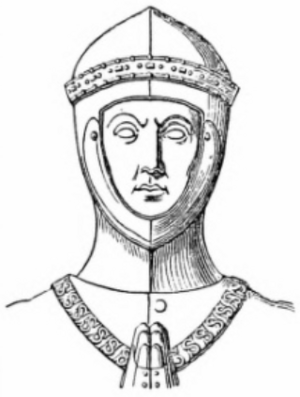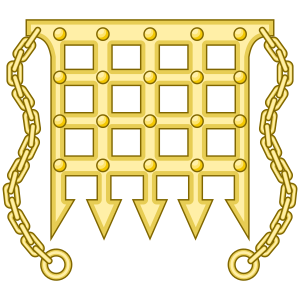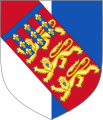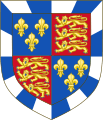John Beaufort, 1st Earl of Somerset facts for kids
Quick facts for kids John Beaufort |
|
|---|---|
| Earl of Somerset | |

Drawing of an alabaster tomb effigy of John Beaufort, wearing a Collar of SS and plate armour, Canterbury Cathedral
|
|
| Born | c. 1373 |
| Died | 16 March 1410 (aged ~37) Hospital of St Katharine's by the Tower, London |
| Burial | St Michael's Chapel, Canterbury Cathedral |
| Spouse | Margaret Holland |
| Issue Detail |
|
| House | Beaufort |
| Father | John of Gaunt |
| Mother | Katherine Swynford |
John Beaufort, 1st Earl of Somerset (born around 1373 – died March 16, 1410), was an important English nobleman and politician. He was the first of four children born to John of Gaunt and Katherine Swynford. John of Gaunt was the third son of King Edward III. His parents later married in 1396.
The Beaufort children were officially declared legitimate, meaning they were recognized as legal heirs, twice by the English Parliament. This happened first in 1397, during the reign of King Richard II. Later, King Henry IV confirmed this. Pope Boniface IX also agreed in September 1396. Even though they were grandchildren of King Edward III, they were not allowed to become king or queen. This rule was made by their half-brother, Henry IV.
Contents
John's Early Life
John's last name, Beaufort, means "from Beaufort." It likely comes from his birthplace, a castle and manor called Beaufort in Champagne, France. The word "Beaufort" means "beautiful stronghold." The famous gate symbol, called a Portcullis, used by the Beaufort family is thought to come from this castle. This symbol is now used by the House of Commons in the UK.

Between May and September 1390, John Beaufort served in the military in North Africa. He was part of a war called the Barbary Crusade. In 1394, he also served with the Teutonic Knights in Lithuania.
John was given the title of Earl of Somerset on February 10, 1397. This happened just a few days after his family was officially made legitimate by Parliament. In the same month, he became the Admiral of the Irish fleet. He was also put in charge of Dover Castle and the Warden of the Cinque Ports. In May, his role as admiral grew to include the northern fleet. That summer, John helped King Richard II gain more power. As a reward, he was given the titles of Marquess of Somerset and Marquess of Dorset on September 29. Later that year, he became a Knight of the Garter. He was also made Lieutenant of Aquitaine, a region in France. Two days before becoming a Marquess, he married Margaret Holland. She was the king's niece. John remained a favorite of the king, even after his older half-brother Henry Bolingbroke (who later became Henry IV) was sent away from England in 1398.
Later Years
In 1399, Henry Bolingbroke took the throne from Richard II. The new king, Henry IV, took away the special titles that had been given to those who supported Richard II. So, John Beaufort became only the Earl of Somerset again. However, John remained loyal to his half-brother, King Henry IV. He served in many military roles and went on important diplomatic missions. In 1400, John was given the lands of the Welsh rebel leader Owain Glyndŵr. But he would only have been able to own these lands if he had lived past 1415. In 1404, he was named Constable of England, a very important position.
John's Family
John Beaufort and his wife, Margaret Holland, had six children. Margaret was the daughter of Thomas Holland, 2nd Earl of Kent. John Beaufort's granddaughter, Lady Margaret Beaufort, married Edmund Tudor, 1st Earl of Richmond. Edmund was the son of Queen Catherine of Valois and Owen Tudor. Lady Margaret Beaufort later became the mother of King Henry VII of England.
John Beaufort, 1st Earl of Somerset, passed away at the Hospital of St Katharine's by the Tower. He was buried in St Michael's Chapel at Canterbury Cathedral.
His children included:
- Henry Beaufort, 2nd Earl of Somerset (1401 – November 25, 1418)
- John Beaufort, 1st Duke of Somerset (born March 25, 1404 – died May 27, 1444) – He was the father of Margaret Beaufort, Countess of Richmond and Derby, who was the mother of King Henry VII of England.
- Joan Beaufort, Queen of Scotland (1404 – July 15, 1445) – She married James I, King of Scots.
- Thomas Beaufort, Count of Perche (1405 – October 3, 1431)
- Edmund Beaufort, 2nd Duke of Somerset (1406 – May 22, 1455)
- Margaret Beaufort, Countess of Devon (1409–1449) – She married Thomas de Courtenay, 13th Earl of Devon.
Important Roles and Titles
John Beaufort held many important positions during his life:
- Lord Warden of the Cinque Ports: 1398
- Admiral of the West: 1397
- Admiral of the Irish Fleet: 1397
- Lieutenant of Aquitaine: 1397
- Admiral of the North and Western Fleets: May 9, 1398 – November 15, 1399
- Lord High Constable of England: 1404
- Admiral of the North and Western Fleets: May 1406 – June 1407
Coat of Arms
As a grandson of King Edward III who was made legitimate, John Beaufort used a special version of the king's royal coat of arms. His arms had the royal symbols but with a special border around them. This border was made of alternating silver and blue squares.
See also
 In Spanish: Juan Beaufort para niños
In Spanish: Juan Beaufort para niños






